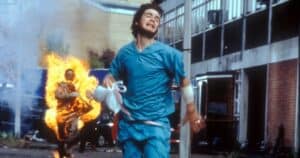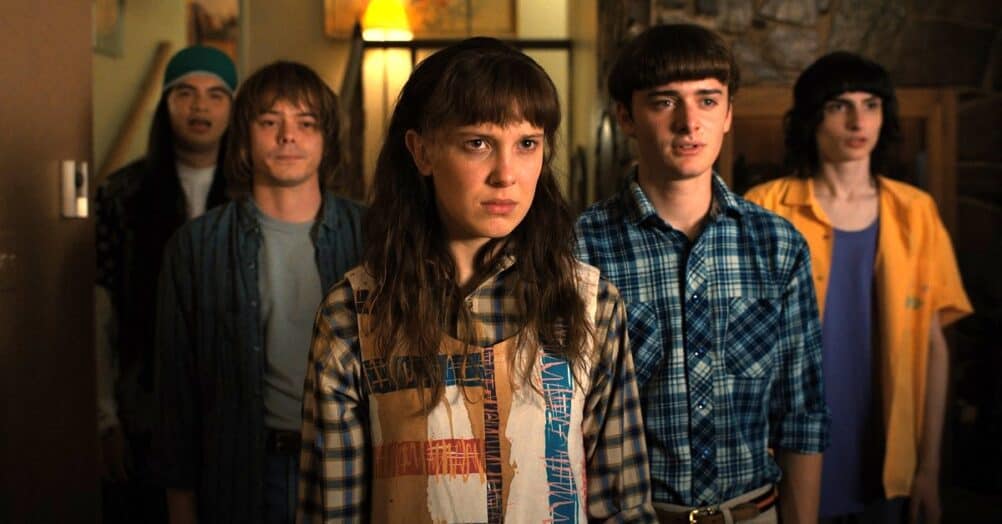Last Updated on July 21, 2021

We all have certain movies we love. Movies we respect without question because of either tradition, childhood love, or because they’ve always been classics. However, as time keeps ticking, do those classics still hold up? Do they remain must see? So…the point of this column is to determine how a film holds up for a modern horror audience, to see if it stands the Test of Time.

DIRECTED BY MICHEL SOAVI
STARRING RUPERT EVERETT, ANNA FALCHI, FRANCOIS HADJI-LAZARO, FABIANA FORMICA
Honest question: If you had a loaded .45 to your temple with only one option to choose, what would you say is the all-time most underrated zombie flick?
Well, aside from an obscure Italian title or two sure to be in the running, if you asked me, I’d confidently lay hard cash on Michel Soavi’s supreme stylistic salvo of sinister slaughter via CEMETERY MAN, aka DELLAMORTE DELLAMORE. What a fantastic horror film! Of course, one of the things about CEMETERY MAN is that, despite how universally venerated it is by damn near all who’ve watched it; the film is still senselessly under-viewed as a whole. Much of this has to do with being an Italian production made independently, outside of the Hollywood studio system. Not to mention the fact the film was made in 1994 but did not receive a theatrical U.S. release until April of 1996, leaving it lost in the winds of a distributional purgatory that Soavi had no control over whatsoever. Well, that’s not entirely true. Word is an American company was willing to produce and distribute the film if Soavi cast Matt Dillon as Dellamore. Soavi stuck to his guns and cast Rupret Everett instead. And even so, because the movie is so ubiquitously lauded for its high quality, you can’t quite call it black sheep so much as an endangered species as an undeniably great movie that’s still wildly underappreciated.
Now, as CEMETERY MAN celebrates its 25th birthday this year, we shall dive into the odious ossuary and exhume its old creakily desiccated bones to see, at the quarter-century mark, how well CEMETERY MAN has either withered under or withstood The Test of Time!

THE STORY: Adapted from the Tiziano Salvi novel by screenwriter Gianni Romoli (TRAUMA, THE SECT), DELLAMORTE DELLAMORE literally translates in Italian as “of death, of love.” This personifies the films protagonist, Francis Dellamore (Rupert Everett), a cemetery overseer for the moldering graveyard in the small town of Bufflora, Italy. Dellamore has one job, which is to kill the dead a second time as soon as their fetid corpses reanimate from grave. Dellamore calls such flesh-starved ghouls Returners, which tend to rise from the loam seven days after death. Simple, right? Oh hell to the no. With only his trusty but mentally impaired pal Gnaghi (Francois Hadji-Lazaro), whose only utterance is “Gna” throughout the film, Dellamore conducts business as usual. When he isn’t burying bodies and braining putrid corpses, Dellamore is contending with town rumors of his sexual impotency, which places squarely in the existential realm of embodying “of love, of death” that his name suggests.
When a gorgeous young woman known as She (Anna Falchi, a more perfect female specimen you will NEVER find onscreen) arrives to the cemetery to visit her dead husband Claudio (Alessandro Zamattio), Dellamore is immediately smitten. The two entangle romantically atop of Claudio’s grave, which enrages her zombified hubby something fierce, and soon Claudio’s out for both She and Dellamore’s blood. She gets bitten and shot in the dome-piece by Dellamore upon reanimation. Only she isn’t dead, which makes Dellamore feel guilty for killing her in the first place. As he’s again torn between death and love, Dellamore spirals into a depression as he longs for She to return in some form or fashion. Bizarrely, a woman who looks identical to She (also played by Falchi) appears, claiming interest in Dellamore precisely because she believes he’s an impotent eunuch. He’s not one at all, but happily pretends to be in order to marry such a beauty. Worse, Dellamore opts to have his cock lopped off for real. The decision of course backfires when the woman cures her penis-phobia, jilts Dellamore and opts to marry her rapist employer instead. F*cking nutso, I know! In the end, Dellamore loses loves and opts for an indiscriminant death-march (hell, his name is Frank of Death after-all!)

WHAT HOLDS-UP: As strong as the aforesaid story remains, it can’t be overstated that CEMETERY MAN is far less about what it makes you think, and much more about how it makes you feel. To this end, what really holds serve about CEMETERY MAN’s lastingly evil elicitations is largely technical. Having just watched the film again this week, I can safely say the aspects of CEMETERY MAN that have rotted the least are its sumptuous setting and atmospheric production design, its striking cinematography and indelible imagery, and of course, the gory practical FX work. Let’s dig up the connective tissue and take a closer look…
First off, the sheer conceit of setting a horror film almost entirely inside a graveyard, an inherently creepy environment for death to persist, is beyond brilliant. There’s such instant and authentic production value in the case of CEMETERY MAN, as the sets for the cemetery were actually built atop a real abandoned cemetery ground in Italy. We all have our own fears, anxieties and personally tragic anecdotes visiting graveyards in our lives that one cannot help but bring that baggage, however subconscious, to the screen when viewing the film. Top tier Italian production designer and set decorator Massimo Antonello Geleng brings to vivified life the gnarliest of putrefying death, as only someone who has worked with Fellini (AMARCORD, CASSANOVA), Fulci (CITY OF THE LIVING DEAD), Deodato (CANNIBAL HOLOCAUST, HOUSE ON THE EDGE OF THE PARK), Martino (SCREAMERS), Lenzi (GHOSTHOUSE) Bava Jr. (DELIRIUM, THE SCORPION WITH TWO TAILS) and Argento (THE STENDHAL SYNDROME, THE CARD PLAYER) only could.

Really, Geleng is an absolute maestro at his craft of world-building and enrapturing audiences with immersive mise-en-scene. CEMETERY MAN is absolute beyond reproach in this area, for when combined with Soavi’s stylistic flourishes – the howling winds, drenching fog, fluttering firelight and grotty and grungy surroundings – augmented by Mauro Marchetti’s lavish lensing nd dynamic camerawork, the movies sensorial sights and sounds envelope just as relentlessly as the zombies attack Dellamore. Before we highlight Marchetti’s masterful contributions, mention must be made of the ossuary in the film, which is first introduced when Dellamore takes She to visit her odd infatuation with the bone-yard. For f*cks sake, this is was a real ossuary that Soavi shot in! And word is a crew member removed a few of the bones early in the shoot, but was quickly forced to return the bones to the ossuary the following day after a pissed-off ghost confronted the crewmember. Tall tale or not, the point is that Soavi chose a real place of terror to film in, which, through an eerie osmotic effect, can’t help but sort of seep its macabre menace through the celluloid of the film itself. Even Soavi would agree, as he’s on record attributing the zombies’ energy to the Mandragola root beneath the cemetery.
As for Mauro Marchetti, he’s equally decorated as Geleng, having collaborated as DP or assistant cameraman with the likes of Argento (FOUR FLIES ON GREY VELVET), Aldo Lado (WHO SAW HER DIE), Bertolucci (1900, LAST TANGO IN PARIS, THE LAST EMPEROR), Coppola (APOCALYPSE NOW), Altman (POPEYE) and Beatty (REDS). Dude literally trained under some of the all time best film directors, and you can see what a keen eye for space, light, color and shadow he has in CEMETERY MAN. The entire visual vocabulary is expressed in the film, from high and low angles, long and short takes, deep focus shots and extreme close-ups, tracks, pans, dips, whips, they’re all on dazzling display throughout the film, vividly depicting the stubbornness of death to relent. One sequence that perfectly typifies how Marchetti’s sumptuous cinematography aptly mirrors not just the subject matter but the aforesaid production design, is the dizzying 360-degree speed-pan around Dellamore on the cemetery grounds. Soavi and Marchetti keep the lens trained on She as she continues to circle Dellamore, whose back remains to the camera, increasing the speed each go around until a deeply disorienting sense of dread takes hold. It’s a masterful shot that serves as a mere microcosm of the films splendid craftsmanship across the board. Another perfect example is the surreal make-out scene between She and Dellamore, as the hovering lights around their heads are meant to reflect “Ignis Fatuus” (“Fool’s Light”), a naturally occurring and free-floating light emitted at twilight around swampy areas.
As for the gouging grue, much of the muscular imagery derives from the production design and cinematography, but it’s also in the practical FX work employed tactfully by Soavi. For as stylized as his camera framing is, he shoots the violence with as much low-tech realism is possible in order to keep the horror grounded in a sense of believability, while still imbuing the action with a sense of manic surrealism. Granted, much of the violence inflicted on Dellamore’s behalf comes at the barrel of a gun, often exploding rotten zombie brains from an exit wound on their pallid heads. Key makeup and FX men Gino Zamprioli (ONCE UPON A TIME IN AMERICA) and Sergio Stivaletti (DEMONS, DEMONS 2, OPERA, THE CHURCH) bring their expertise to realize a retching recipe of chewed up flesh, clotted blood and decaying bone.
WHAT BLOWS NOW: Outside of 10-12 minutes of drag in the second half, I really have no qualms as to the sturdiness of CEMETERY MAN in 2019. That said, there have been a few tidbits that have come to light over the years that makes you scratch your head in retrospect. The first is that, reportedly Tangerine Dream was originally set to score the film and compose the soundtrack, but something sidetracked the band last minute and forced them not to. While I always dug the score by Vittorio De Sica’s son, Manuel, in CEMETERY MAN, one can’t help but think how the Tangerine Dream sound-scape would have played over the films indelible imagery. Also, word is once Everett enjoyed success in America in the 90s, he asked Soavi to make an Americanized version of the film. It never came to, which is probably for the better. However, I don’t think a single fan of CEMETERY MAN would be averse to Everett and Soavi making a sequel around that time. Yet, we’re without one, and that blows now!

THE VERDICT: We stand convicted, CEMETERY MAN is the single most underrated zombie flick ever made. Ever! And it’s really not even the story that makes it so as much as it’s the intrinsically eerie setting, the macabre ambience of the production design, the atmospheric dread evoked by the rich cinematography, and the practically produced gore Soavi was able to capture onscreen. All things considered, 25 years damn sure isn’t long enough to decompose CEMETERY MAN!

















Follow the JOBLO MOVIE NETWORK
Follow us on YOUTUBE
Follow ARROW IN THE HEAD
Follow AITH on YOUTUBE